Electoral reform is on the agenda of two of the major parties vying for power in Ottawa this October. The Liberal Party of Canada has promised to move Canada away from its traditional first-past-the-post electoral system towards more meaningful representation. The precise destination has not been announced yet, and this has rekindled the debate about the relative merits of different voting systems. Earlier, the NDP had already endorsed a particular voting system known as "Mixed Member Proportional" (MMP) representation. In the background looms a much bigger question. Will a different voting system improve democratic engagement and participation? Falling voter turnout points to rising voter apathy, and this is particularly pronounced among young voters.
That our current first-past-the-post system can lead to peculiar outcomes British Columbians experienced in 1996. The provincial election gave one party 42% of the vote and 33 seats, and another party 39% of the vote and 39 seats. The party with the plurality of votes lost the election. Five years later the tables turned and one party won 58% of the votes and 97% of the seats, and the other party won 22% of the votes and 3% of the seats. The losing party was almost entirely wiped up from parliamentary representation. In the same election, a party that received 12% of the vote ended up with no seats at all. Are these outcomes fair?
More recently, the provincial election in Alberta put the NDP in power with 62% of the seats (53 out of 86), but only 40.6% of the votes. Together, the two right-of-center parties gathered 52.0% of the vote. Three-way votes as those in Alberta can turn mere pluralities turn into governing majorities. Ontario's 1990 election is another example, where the NDP won 37.6% of the vote but 57% of the seats. Similarly, the 2011 federal election put the Conservatives into power with 53.9% of the seats but only 39.6% of the votes. Whether these outcomes are desirable depends much on where you find yourself on the political landscape. It certainly makes election outcomes less predictable, and may well distort—if not misrepresent—voter intent. As the Globe and Mail's Jeffrey Simpson pointed out, the electoral system favoured Alberta's NDP this time, but if the election had been held under the electoral system that the NDP favours, Alberta would likely be governed by a coalition of the two right-of-center parties, a coalition of the NDP with the Progressive Conservatives, or perhaps a minority government. Electoral reform is never appealing to the winner.
Another problem ailing our electoral system is low voter turnout. Elections Canada reports that voter turnout has been falling since the 1990s. Originally around 75-80%, it has dropped to around 60% in the last two elections. However, this average rate masks big differences across age groups. Only 39% of 18-24-olds voted, and only 45% of 25-35-olds. However, participation rates among 55-64 and 65-74 olds reached 72% and 75%, respectively. No surprise, then, that elected politicians cater to the special needs of those who vote for them: the 55+ generation. Is Canada's democracy losing its young? Why are so many young people apathetic about politics? Is it lack of information, lack of interest, or is it cynicism about all the dishonesty, hypocrisy, corruption and negativity in politics? What can be done to increase participation and re-engage young people? Is electoral reform a crucial step towards re-engaging young people?
What is clearly broken in our electoral system is the high proportion of ridings that are won without a clear majority. In the 2011 election, a majority of ridings were won without a clear majority. Out of the 308 seats in parliament, 163 were won with less than 50% of the vote. As the chart below shows, there is great variation across provinces in that regard. As a simple rule of thumb, seats in the prairie provinces tend to be won with clear (>50%) majorities, while other provinces tend to have only (<50%) pluralities. In Quebec, eight out of ten ridings were captured with simple pluralities but without clear majorities. The record for smallest pluralities are held by Vancouver Centre, BC (31.0%) and Ahuntsic, Quebec (31.8%), where the outcomes were determined in tight three-way races.
The next diagram shows the distribution of winning vote shares across all of Canada. The red bars indicate (<50%) pluralities, and the green bars indicate (>50%) majorities. The red area is actually larger than the green area, even though the green area has a long tail of riding that are won with large vote shares.
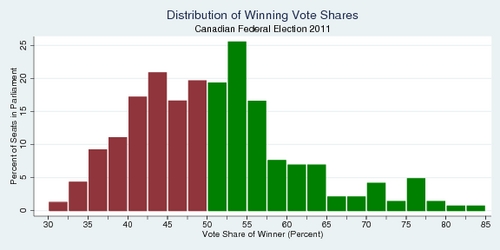
click on image for high-resolution PDF version
Another way to look at this issue is to tabulate the winning margin in each riding, that is the percentage point difference between the winning candidate and the second-placed candidate. The diagram below shows how tight many races are. Some 10% of ridings are won with a margin of less than 2.5%, and about a quarter of all ridings are won with a margin of less than 10%.
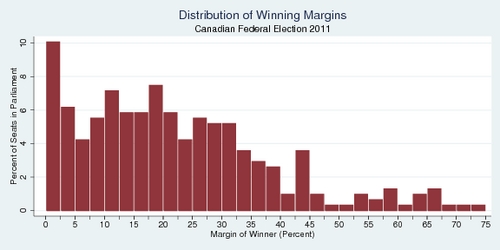
click on image for high-resolution PDF version
It is also interesting to look at the actual number of votes that winning candidates received. The diagram below illustrates that some members of parliament were elected with the support of less than 5,000 voters, while some members of parliament were elected with the support of close to 50,000 voters.
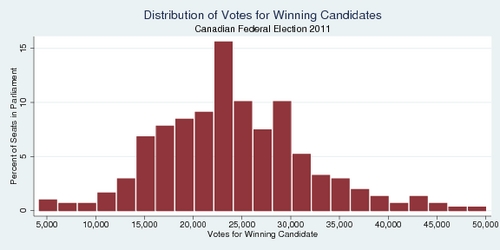
click on image for high-resolution PDF version
One last chart illustrates the final problem with our first-past-the-post system in Canada. The size of ridings can vary dramatically. Ideally, ridings should represent roughly equal number of voters. In reality, constitutional rules and political expediency put a dent in that. Representation of P.E.I. and the Territories is subject to preferential treatment; these ridings are significantly smaller than "regular" ridings. The chart shows the number of eligible voters in each riding (not the entire population). The mean is about 78,000 voters per riding, but the standard deviation is a whopping 17,000. The largest riding had 151,584 voters: Oak Ridges-Markham in Ontario. Why should voters in P.E.I. have more representation in parliament on a per-capita basis than voters in Ontario? Redistribution of seats for the October 2015 election, which also raises the total number of seats from 308 to 338, alleviates the misrepresentation somewhat, but large inequities remain.
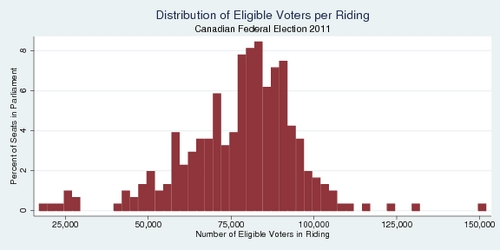
click on image for high-resolution PDF version
Having grown up in Germany and immigrated to Canada, I have first-hand experience with Canada's first-past-the-post majoritarian system and with Germany's proportional representation (PR) system, although the latter includes several twists. It is easy to see the benefits of both systems, and the trade-off between them. Majoritarian systems tend to produce clear majorities and stable governments, while proportional representation systems tend to produce coalition governments. On the other hand, majoritarian systems often distort representativeness because political parties can win a majority of seats with less than the majority of the votes. Furthermore, parties that are locally strong but account for a small overall vote share can gain numerous seats, while smaller parties with broad but evenly-distributed support may fail to win any seats. (In the Canadian context, think about the Bloc Quebecois and the Green Party in the 2008 election.) Political scientists envision this as a trade-off between representativeness on one axis and accountability on the other axis. As shown in the left diagram below, proportional representation delivers better representation of electoral preferences, while first-past-the-post electoral systems deliver greater accountability of elected politicians to their constituencies. At least that is the theory.
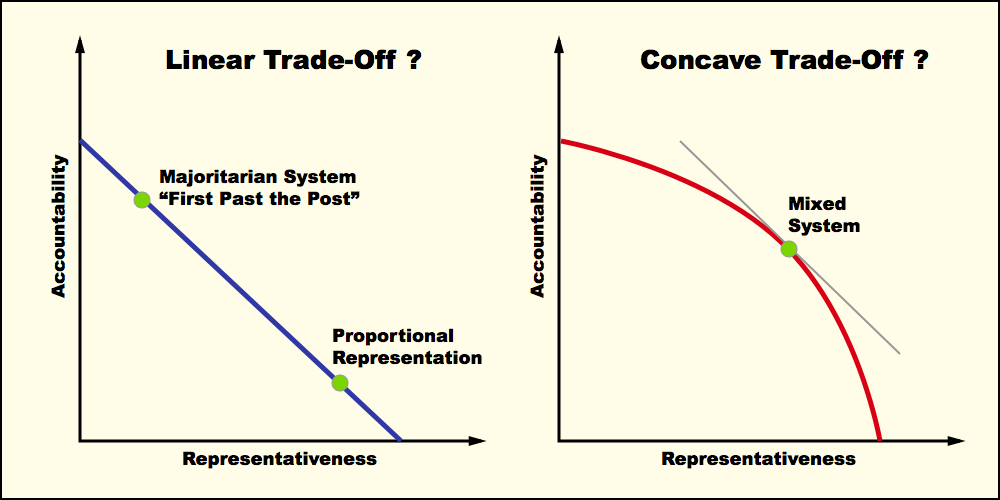
‘Hybrid electoral systems are better than pure electoral systems.’
As Carey and Hix (2011) argue, the trade-off between the two dimensions representativeness and accountability may not be a simple linear transformation as the left diagram above suggests. Perhaps the trade-off is better thought of as a concave transformation—something that economists would readily recognize as a production possibility frontier. Moving to the middle may improves one dimension a lot more than it costs in terms of the other dimension. The authors argue that there is an electoral sweet spot. They find that electoral systems that use low-magnitude multi-member districts produce disproportionality indices almost on par with those of pure PR systems while limiting party system fragmentation, producing simpler government coalitions, and surpassing both majoritarian and pure PR systems on some indicators of government performance. In short, hybrid electoral systems are better than pure electoral systems.
Germany's system for its federal election gives voters two votes. The first vote is for electing a local candidate in a simple first-past-the-post system. The second vote is for electing parties to parliament in proportion to their overall share of votes. In order to participate in this allocation of seats, parties must either win a minimum of three direct seats or a minimum of five percent of the national vote. The electoral threshold is meant to prevent fragmentation. Many other countries that use PR systems also use election thresholds of various levels.
Voters across Canada have been lukewarm to the idea of electoral reform in several referendums. In British Columbia, voters got a chance in 2005 to vote in a new electoral system known as the "Single Transferable Vote", in which voters could rank candidates in multi-member districts of different size (2-7 seats). Even though a majority of voters supported electoral change (58%), the referendum failed because it did not reach the required 60% super-majority. In 2007, a referendum in Ontario for a mixed-member proportional representation (MMP) system failed as well.
Proposed changes for federal elections in Canada include relatively benign changes such as preferential voting. Here, voters simply rank candidates on their ballot rather than marking just an "X" for their preferred candidate. In this type of "instant runoff" system, if a candidate fails to win an outright majority in a constituency, the second and third preferences get reallocated until one candidate reaches a 50% majority. This system maintains individual constituencies but avoids multi-party splits. Another version involves a second-round of voting.
‘Electoral reform is overdue but alone will not solve the problem of voter apathy.’
Considering the large distortions that Canada's first-past-the-post produces, I welcome a reform of our electoral system. Moving to preferential ballots would be the most benign change, but moving to MMP or STV would be even more desirable. However, two key aspects of elections need to be preserved at all cost: transparency and credibility. Voters need to remain convinced that elections are conducted fair and square, without counting shenanigans. Elections should be simple enough that they can be conducted on paper ballots in scrutinized by volunteers. The complexity of STV is a drawback despite its many desirable characteristics, while MMP (with a few bells and whistles as in Germany) may ultimately be simpler and more transparent.
In my view, the case for electoral reform in Canada is strong. There are three overarching problems. First, we have a three party system rather than the two-party system that prevails in the United States. This means that is quite typical for parties to win a majority of seats with less than the majority of votes. Second, we have strong regional biases that favour parties with strong local support (such as the Bloc Quebecois) and punish parties with broad but even support (such as the Green Party of Canada). Third, Canada's relatively large share of "unrepresented votes" may increase voter apathy and "political disengagement", especially among the young. Nevertheless, electoral reform is no panacea to to combat voter apathy. It is merely a first step. Tackling voter apathy and re-engaging young people is a much more formidable challenge that will require much more. It strikes me that we will need a lot more research about understanding young people's aversion towards politics.
References:
- Estimation of Voter Turnout by Age Group and Gender at the 2011 Federal General Election, Elections Canada, April 2012.
- John M. Carey and Simon Hix: The Electoral Sweet Spot: Low-Magnitude Proportional Electoral Systems, The American Journal of Political Science 55(2), April 2011, 383-397.
- Law Commission of Canada: Voting Counts: Electoral Reform for Canada, 2004.
- Konrad Yakabuski: Electoral reform: the devil is in the details, The Globe and Mail, June 18, 2015.
- Jeffrey Simpson: NDP may want to reconsider its stance on electoral reform, The Globe and Mail, July 18, 2015.
- Campbell Clark: In reforming voting system, parties favour what benefits them most, Globe and Mail, July 28, 2015
![[Sauder School of Business]](logo-ubc-sauder-2016.png)
![[The University of British Columbia]](logo-ubc-2016.png)